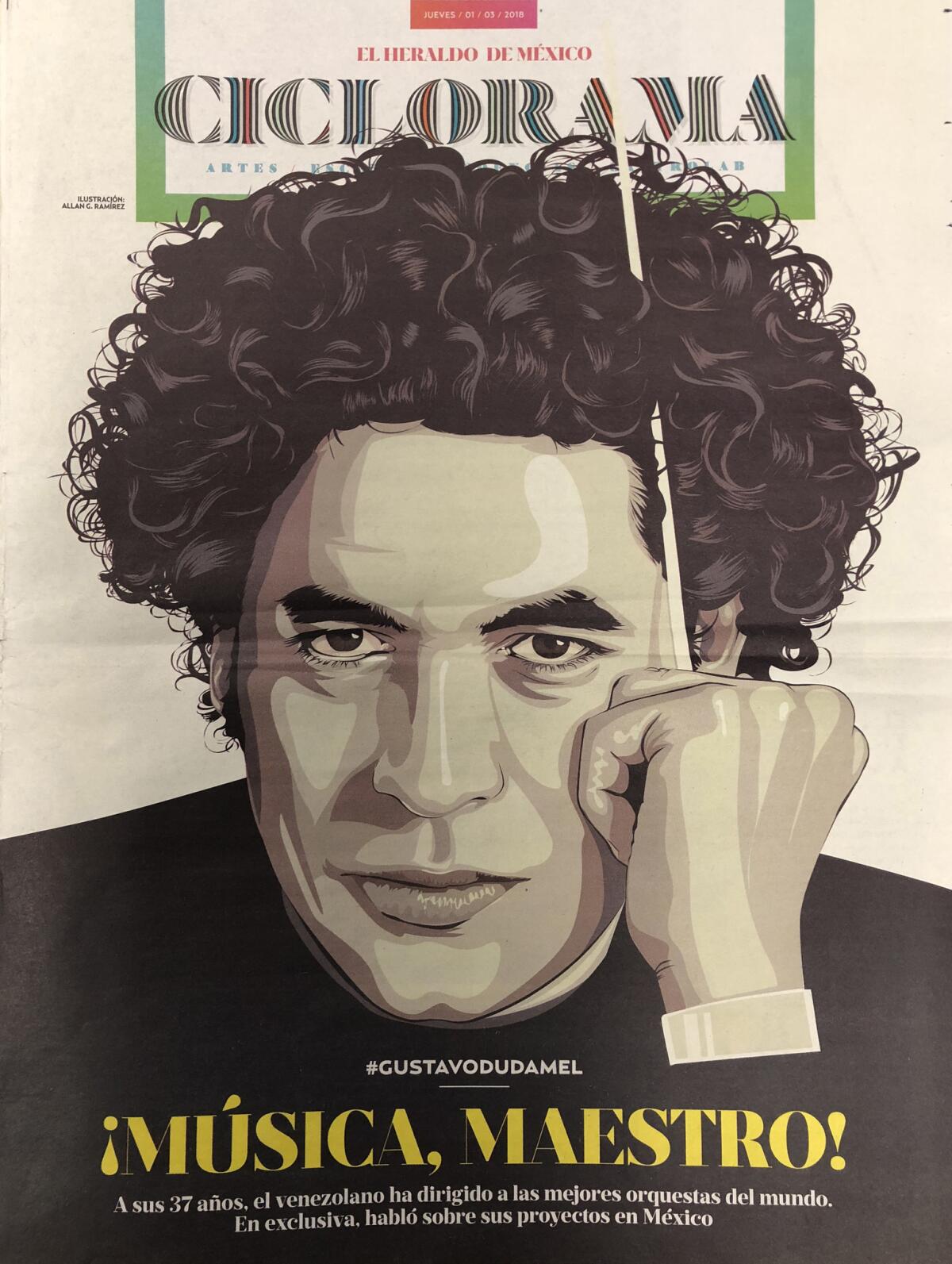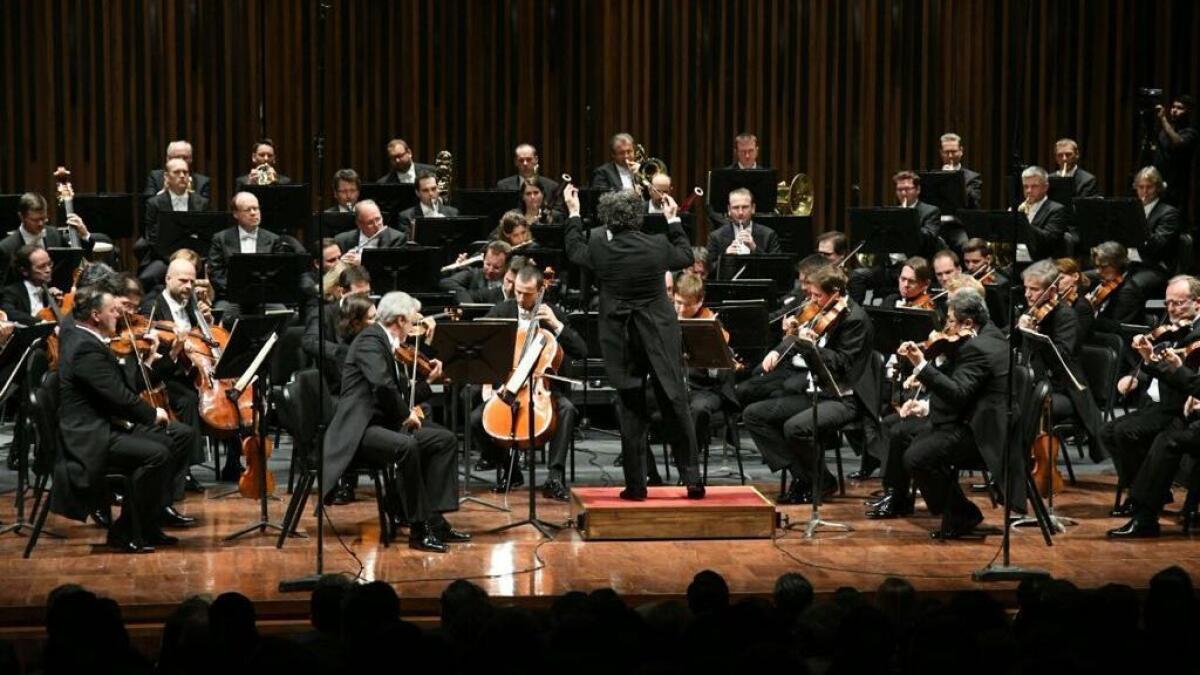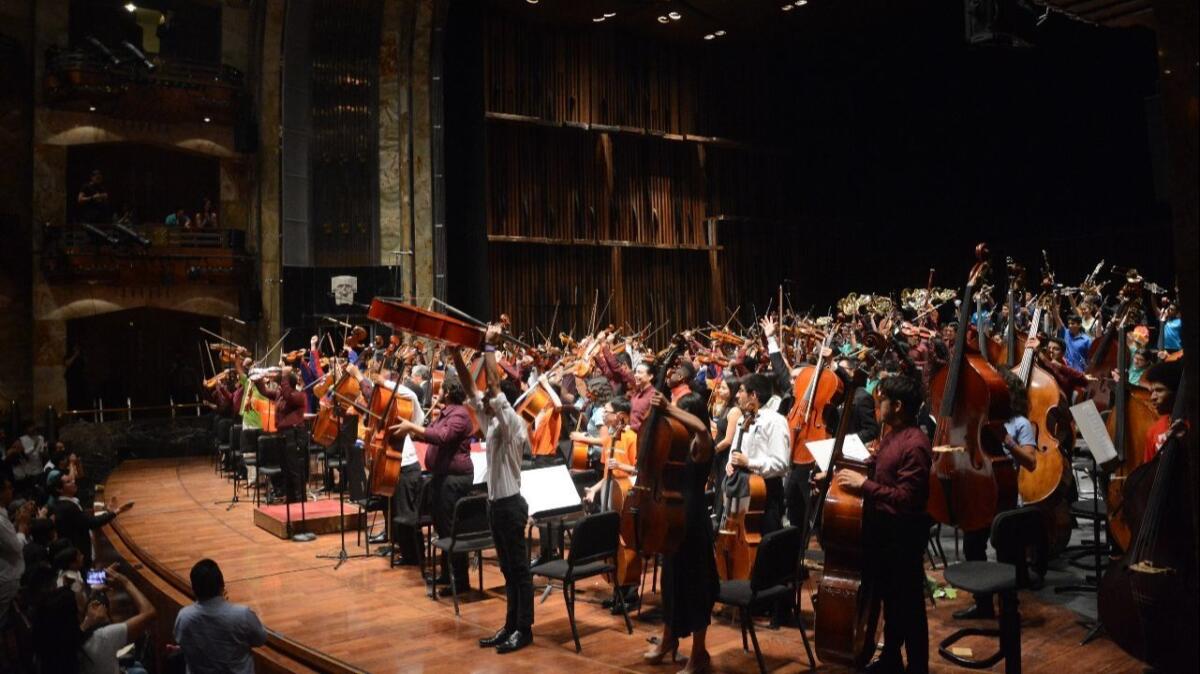In Mexico City, a famed orchestra is no match for the spirit of 160 student musicians led by Dudamel
- Share via
In the conference room of a generic hotel just outside of Mexico City’s historic center, 160 young musicians have crammed themselves with Gustavo Dudamel for a rehearsal of the last movement from Dvorák’s “New World” Symphony. The conductor urges the kids, ages 9 to 21, to slow down and savor a delicious melody. “Don’t eat the chocolate with the paper. Never,” he says. “Enjoy.”
He shows the strings how to create a tremolo, like a bird that rapidly flaps its wings but gives the sensation of floating. He then unleashes the full brass and percussion with a buoyancy that competes with the overwhelming color and spirit of Mexico City street life, loud and forceful enough to pin against the wall a few observers who happily squeeze into the room.
Forty-five minutes later at the glorious Palacio de Bellas Artes — the spectacular concert hall with monumental murals created for its lobby by Diego Rivera, José Clemente Orozco and Rufino Tamayo — the hallowed guardian orchestra of the Old World, the Vienna Philharmonic, awaits Dudamel for a brief rehearsal for its evening concert. He arrives dressed in the same black T-shirt, Levis and Adidas sneakers as in the earlier rehearsal.
Beyond that, little is the same. A mere Mexico City mile blatantly separates classical music’s Old World and New. You could walk it in 20 minutes, as I did, and feel the modern world slip away from you. There is no question where the future of classical music and — if we want to be smart about it, society — lies.
For the moment, though, the future is behind the scenes. Media hullabaloo necessarily surrounded the Vienna Philharmonic’s two-week Americas tour with Dudamel, which began at Carnegie Hall in New York and winds up in Buenos Aires on Saturday. The orchestra has made few appearances in Mexico, the last being with Riccardo Muti a dozen years ago, and before that in 1981 with Carlos Kleiber.

Given Dudamel’s rock-star celebrity in Latin America, Vienna’s two programs at the 1,300-seat Bellas Artes sold out within one hour. A third concert at the 10,000-seat Auditorio Nacional was scheduled for the same time as the Academy Awards ceremony, which was of obvious interest because Mexican director Guillermo del Toro’s “The Shape of Water” was a front-runner.
No matter. The venue was full for Vienna. From what I could tell scanning the capital’s many newspapers, attention for Dudamel was even more massive than that for Del Toro.
The Vienna Philharmonic performances were impressive in ways not difficult to predict by anyone familiar with the Los Angeles Philharmonic’s music director or this incomparable orchestra. Dudamel first worked with the Vienna Philharmonic in 2007, when he was 26, and he has since conducted it more than 100 times. The tour repertory stayed mostly within the narrow Viennese comfort zone with one notable exception, Charles Ives’ Second Symphony.
The symphony was a gracious, if half-hearted, gesture by the Vienna Philharmonic to connect its tradition to the New World. Ives, for instance, might begin a phrase with “America the Beautiful” and let it tail off beautifully into something from Brahms’ First Symphony. Vienna happens to be the best orchestra in the world when it comes to unwrapping the paper and savoring the chocolate. For them, “America the Beautiful” was the paper to be tossed away, a prelude to Brahms, not with the accent where Ives’ had it, using American music to wave goodbye to Europe.
However misplaced the accents, this was a beautiful Viennese tribute to America, with every detail exquisitely balanced, down to the last chord — raucously dissonant with every note of the scale but one — treated as a respectful raspberry.

Elsewhere in the two Bellas Artes programs, Dudamel took reverential advantage of the orchestra’s greatest strengths. Tchaikovsky’s Fourth Symphony was extraordinary in the blend of richly dark instrumental colors and breathtaking virtuosity. Brahms’ Symphony No. 1 had the meticulous grandeur that Dudamel’s performance with the L.A. Phil in Walt Disney Concert Hall had a couple of weeks earlier, although here it sounded more coddled, a massive monument to be protected from all fingerprints and not to be moved a fraction of an inch.
A fashionable, sophisticated and marvelously intent audience aided the atmosphere, even when the luscious Viennese cream turned sour during a performance of Mozart’s Flute Concerto No. 2. Although Dudamel attempted to sculpt a nuanced performance of the concerto with the orchestra, the orchestra’s unpleasant principal flutist, Walter Auer, tried to conduct at the same time, wanting little more from his colleagues than an urging on of his own blandly, if showy, bluster.
But none of this had the sheer immediacy of music making, the sense of life and death hanging on getting a note to sing, that was on display in the Encounters program Dudamel masterminded especially for the Mexico City tour stop and helped to fund through his Gustavo Dudamel Foundation. The foundation of Mexican composer (and CalArts graduate) Arturo Marquez, who was co-director of the workshops, also chipped in.
Students were selected from education programs throughout the Americas — from Moncton, Canada, to Chascomús, Argentina. The majority were from the U.S. (including four graduates of the Los Angeles Philharmonic’s YOLA program, all now college music majors) and Mexico (with the youngest players representing 17 states in the country). Dudamel handpicked an international faculty, which included noted instrumental players (including Simon Bernardini, a violinist in the Berlin Philharmonic), soloists and educators.
This culminated in a Sunday morning concert in the Bellas Artes for the families and friends of the young players, plus dignitaries and press. Marquez conducted his own “Alas (a Malala),” an electrifying Caribbean-style dance written in tribute to the Pakistani activist and educator Malala Yousafzai, who was awarded the 2014 Nobel Prize for Peace. The orchestra musicians swayed in their seats, and a local youth chorus executed stirring hand movements while it sang, successfully employing a tuneful earworm I have yet to shed.
The “New World” Finale under Dudamel had a special emotional significance when played by an orchestra nearly twice the size of the Vienna Philharmonic and composed of inexperienced players who had been together only a few days and who spoke different languages. So did an Adagio for strings by John Williams, who adapted his score to “Star Wars: The Force Awakens” as a present to Dudamel.
But as Dudamel told the kids, “It’s not for me; it’s for you.” The piece may be used only for educational purposes. The music cannot be recorded, the score cannot be copied. Here, indeed, was a meaningful place for reverence. For these kids, Williams is their Mozart, and they brought to the music spiritual awe.
The final night of the Vienna Philharmonic residency began with one of the most cosmic of all Adagio movements, the one that opens Mahler’s unfinished Tenth Symphony, his last music. I can’t say all that much about how it sounded with Vienna, since all I could hear in the Auditorio Nacional was a nearby loudspeaker with only slightly more ability to capture tonal nuance than a portable Bluetooth speaker I had in my suitcase.
But this was, nonetheless, a special occasion. The least expensive seats were around $10. The audience was as quiet and attentive as that in the Bellas Artes. Friends in New York told me that they thought Dudamel’s Carnegie performance of the Mahler lacked passion and intensity. Perhaps because of the need to reach people in distant seats, this performance had plenty of both.
I learned afterward that the atmosphere so impressed the orchestra musicians that they asked for the lights to be turned on during applause in the second half, after Berlioz’s “Symphonie Fantastique.” They wanted to see for themselves what this extraordinary crowd looked like.
Could it be that the radical left-wing murals in Bellas Artes had a subliminal populist effect on a pampered orchestra that rarely leaves the confines of fine concert halls and that prides itself on charging an arm and a leg? The Berlioz was a knockout, however crummy the sound system. Afterward, Dudamel, who is especially proud of how much the amplification at the Hollywood Bowl has improved since his debut there 13 years ago, said that he has already spoken to the Auditorio Nacional sound people about ways to improve their loudspeakers.
The South American country to which Dudamel would have most wanted to bring the Vienna Philharmonic, of course, is his native Venezuela. It is in shocking economic decline. And Dudamel is persona non grata with the authoritarian Venezuelan regime after calling for basic freedoms. Even so he maintains daily contact with Caracas, mentoring students over Skype and participating in meetings for El Sistema music education program. Moreover, Dudamel did manage to bring Venezuelan students and faculty to be part of the Mexico City encounters, the orchestra musicians proudly wearing their flag jackets during the concert.
Having been away from Venezuela for a year, Dudamel appeared especially happy and relaxed to be in a great Latino capital, going dancing in clubs after concerts and running his handlers ragged. In a brief chat after his final concert, he seemed elated and told me that he is, indeed, planning to return to Venezuela, most likely in June, after he finishes the L.A. Phil season.

The biggest entertainment stories
Get our big stories about Hollywood, film, television, music, arts, culture and more right in your inbox as soon as they publish.
You may occasionally receive promotional content from the Los Angeles Times.








